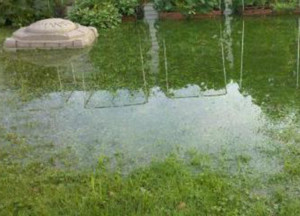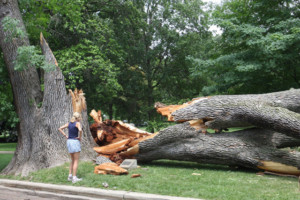 From nearing record heat and drought to breaking all records for rainfall during the month, we have lived through a wet and wild weather month this July. We have survived, but hopefully our plants have, too!
From nearing record heat and drought to breaking all records for rainfall during the month, we have lived through a wet and wild weather month this July. We have survived, but hopefully our plants have, too!
As we watched the weather zap the moisture from lawns and gardens, we issued a watering alert to you all, advising everyone to be sure to water everything in their yard. Just as we were about to announce a second warning, a period of storms began that led to the single most rainfall in a day with nearly 7” falling in the Chicago area on July 23rd, 2011. That was followed by several more severe storms with heavy rainfall to end the month, breaking the record held since 1889. What a crazy weather month for us and our landscaping.
 What does this mean for your garden and lawn? Most plants will incur damage from all this water, if their roots are saturated with water for longer than 24 hours. If your yard is soggy but not under water, the larger plants are probably going to be fine. However, in shady areas with water-logged soils we are seeing grass begin to rot out. Luckily, mid to late August is an ideal time for overseeding to establish a new lawn before winter. We have also noticed powdery mildew and other fungus diseases on the lawn. These usually resolve themselves, but if you are concerned, and the lawn seems to be in serious decline, it can be treated with a fungicide. We have had several calls about mushrooms and colorful slime molds in lawns and mulched beds. These are nature’s way of breaking down decomposing organic matter, and they won’t hurt any living things. They can be scraped away if they are bothersome. NEVER eat a mushroom you find in the garden unless you are sure they are not poisonous!
What does this mean for your garden and lawn? Most plants will incur damage from all this water, if their roots are saturated with water for longer than 24 hours. If your yard is soggy but not under water, the larger plants are probably going to be fine. However, in shady areas with water-logged soils we are seeing grass begin to rot out. Luckily, mid to late August is an ideal time for overseeding to establish a new lawn before winter. We have also noticed powdery mildew and other fungus diseases on the lawn. These usually resolve themselves, but if you are concerned, and the lawn seems to be in serious decline, it can be treated with a fungicide. We have had several calls about mushrooms and colorful slime molds in lawns and mulched beds. These are nature’s way of breaking down decomposing organic matter, and they won’t hurt any living things. They can be scraped away if they are bothersome. NEVER eat a mushroom you find in the garden unless you are sure they are not poisonous!
 Ornamental grasses and heavy flower heads of hydrangeas and other flowers have been bent down with the rain. Propping them up with a garden stake will restore them to their beauty. Leaf spots seem to be everywhere… typically the fungus that caused them is gone, but the blemish remains.
Ornamental grasses and heavy flower heads of hydrangeas and other flowers have been bent down with the rain. Propping them up with a garden stake will restore them to their beauty. Leaf spots seem to be everywhere… typically the fungus that caused them is gone, but the blemish remains.
Many trees and shrubs sustained damage from the strong winds and will need pruning. If you had a tree struck by lightning, contact an arborist for evaluation, it may not show signs for weeks or months, but it could have been weakened and have become a hazard to property.
 We are ending the month of July with record-setting rainfall, but this doesn’t mean we don’t need to water again until September! As always, watering our outdoor green space does not mean that one or two storms will sustain our plants for weeks on end. It is important to watch the amount of rainfall each week and the condition of your yard to determine the need for watering. Normally, on average your garden will need at least 1” per week in order to maintain healthy blooms and good color from you plants, trees and lawn. If the plants are newly installed (less than 2 seasons in your yard) they will need more water, closer to 2″ in a week’s time. It is easy to check if its time to water by exploring the moisture level in your planting beds or below your sod. Simply dig into the soil and touch the soil. If the first 3-4” below the surface are dry, its time again to water.
We are ending the month of July with record-setting rainfall, but this doesn’t mean we don’t need to water again until September! As always, watering our outdoor green space does not mean that one or two storms will sustain our plants for weeks on end. It is important to watch the amount of rainfall each week and the condition of your yard to determine the need for watering. Normally, on average your garden will need at least 1” per week in order to maintain healthy blooms and good color from you plants, trees and lawn. If the plants are newly installed (less than 2 seasons in your yard) they will need more water, closer to 2″ in a week’s time. It is easy to check if its time to water by exploring the moisture level in your planting beds or below your sod. Simply dig into the soil and touch the soil. If the first 3-4” below the surface are dry, its time again to water.
Below we have provided some simple watering guidelines:
Trees and Shrubs: Place the open end of the hose at the base of the plant and allow it to gently flow onto the root ball of the plant. The rate of flow should be such that it soaks into the soil without running off or puddling. You can water each plant individually, ten minutes per four feet height of plant, or place a sprinkler to cover the area for several (3) hours.
Groundcover and Perennials: These plants have much smaller root balls than their woody companions and thus will need more frequent watering. Sprinklers are the easiest way to apply water. A sprinkler should be set to run for 1 to 2 hours allowing water to penetrate the top 6 – 12” of soil.
Don’t forget to water your lawn! After 2 weeks without rain, the crowns start to die. Your watering should penetrate 8 – 10” into the root zone to be adequate.
If you have an irrigation system check for “dry pockets”. As plants grow, the spray may not reach all the way to the back of the bed or over the taller perennials. We recommend running through the entire system during the day watching as each zone works to be sure it is irrigating all your plants.
Remember to give your yard the attention it deserves and protect both the value and beauty of your landscaping. For more information call us or visit our website at www.naturesperspective.com.
